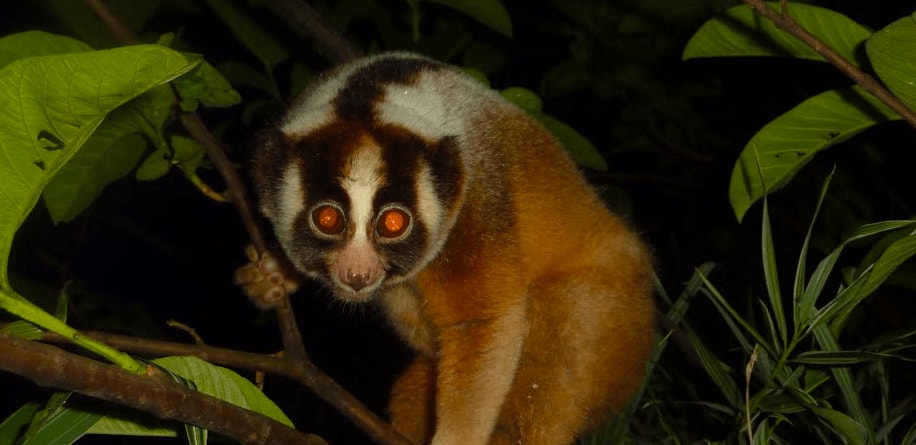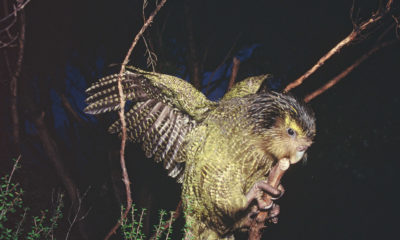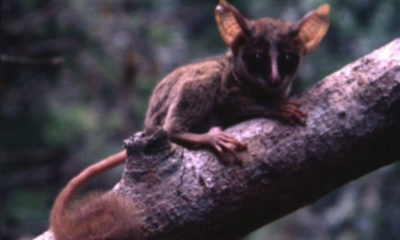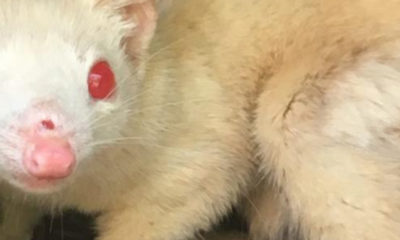Conservation
Javan Slow Loris
Deep in the fog forests of Western Java, where mist is more common than sun and gases condensate into low-level cloud, a small, wide-eyed creature sits frozen with fear as a poacher approaches its branch. Unable to move, it is easily captured. Another Javan Slow Loris is taken for the pet trade
Published
8 years agoon

Species: Nycticebus javanicus | Conservation Status: Critically Endangered | Region: Java, Indonesia | Interview: Chris Wiggs, International Animal Rescue
About the Javan Slow Loris
The name Slow Loris can refer to any of the four species and two subspecies within the Nycticebus genus. In this report, we will focus on the case of the Javan Slow Loris (Nycticebus javanicus).
As its name suggests, the Javan Slow Loris is endemic to the Indonesian island of Java. This means that it has a very small range, one of the key factors leading to its declaration as critically endangered by the International Union for Conservation of Nature (IUCN). The IUCN defines a species as critically endangered when its numbers have declined by 80% or more in three generations – a dire situation. Little is known about the current population size of the Javan Slow Loris, but we do know that they are suffering catastrophic poaching.
The Details
The Slow Loris is curious among primates as it has only a vestigial tail. This means that they are unable to grip and swing from branches like the new world monkeys with prehensile tails. In this way, the Slow Loris is more akin to small mammals like civets or possums.
Primarily nocturnal, the Javan Slow Loris can travel surprisingly far in its search for food. It is an omnivorous animal and will eat nectar, blossoms, fruits, gums, insects, and small reptiles. Interestingly however, despite this natural varied diet, Richard Moore (2012) noted that reintroduced Javan Slow Lorises spent 90% of their feeding time eating nectars.
Rode-Margono and Nekaris (2014) were among the first to study the social behaviours of Javan Slow Lorises. Previously thought to be predominantly solitary, the study found that the primates spend 13% of time observed within sight of another Loris. For 37% of this time, the Lorises were in bodily contact with one another, often grooming. These findings have implications for rehabilitation and release programs as we now know that Lorises need companions.
The Javan Slow Loris is distinct from the others in the Nycticebus genus because it has a pale face with dark markings and a strong stripe down its back. Its ears are more rounded than the Greater Slow Loris (Nycticebus coucang), with which it is often confused.
Another curious, little-known trait of the Javan Slow Loris, and indeed all Lorises, is its ability to produce and inject venom like a snake. The venom is produced and stored in a gland in its elbows and injected through its needle-sharp teeth. This allows it to defend itself against predators. The Javan Slow Loris does not have a well-developed escape response and, when frightened, it tends to freeze to one spot rather than try to get away. This makes it easier for predators such as hawks, eagles, and snakes to take them.
However, the largest threat currently facing Slow Lorises is poaching for the pet trade.
Javan Slow Loris Conservation
Many will know the Slow Loris only as the cute little creature with big eyes that likes to be tickled under its arms. However, this practice is incredibly cruel and one of the main reasons Slow Lorises are facing such a daunting conservation status.
Some organisations estimate that over 1000 Slow Lorises (all species) are taken from the wild every year. One conservation group recorded finding more than one hundred live Slow Lorises in just five visits to known pet trade markets.
In 2010, a paper by Nekaris et al. studied the cultural drivers behind Slow Loris poaching. Traditional medicine and cultural beliefs that Lorises have mystical powers were big problems for Lorises in Indonesia, the home of the Javan Slow Loris. No Loris body parts were found in the Indonesian section of the survey, but vendors would encourage people to take a live Loris and use the meat to cure diseases like asthma. The majority of the Lorises found in markets in Indonesia are destined for the pet trade.
Nekaris et al. completed 59 monthly surveys of known markets in Indonesia and found a total of 714 Lorises, an average of 12 per month. Based on the known average monthly turnover of these markets, the minimum number of Lorises that may have been involved in trade was 237. However, the real number is more likely to approach 1000.
The report also states that the most common time for Loris hunting was when forests were being cleared for housing developments or palm oil plantations. The clearing exposes the Lorises so they can be found and collected more easily.
Becoming a Pet
For a Slow Loris to become a pet, it first needs to be cruelly taken from the wild by poachers. Then it will be forced into tiny cages, often with several other Lorises, to be transported to the pet market. Here, its teeth are removed, without anaesthetic, so that it will not be able to bite and poison its future owner. The practice of removing teeth often results in infection and death for the Loris. It also makes rehabilitation back into the wild impossible.
International Animal Rescue helps hundreds of poached Lorises every year, and Chris Wiggs works at their rehabilitation centre in Ciapus, Java.
He says that there are currently 157 Lorises at the centre, including 61 Javan Slow Lorises. The centre is at capacity and more space is required every year as more Lorises are poached and in need of rescue. Where possible, the rehabilitation aims to send Lorises back to the wild. To date, 44 have been released with tracking devices since the program began. However, not all Javan Lorises can be released. There are major challenges in terms of the animal’s health and ability to survive that need to be overcome.
International Animal Rescue Work
Wiggs outlines International Animal Rescue’s role in Loris conservation as one of “rescue, rehabilitation and release.”
In addition to this, they run outreach programs in places like shopping centres, urging people not to buy Lorises and to be more environmentally friendly. There are also programs in schools aiming to teach young people about the ways in which forest ecosystems are important and why Lorises do not make good pets.
On top of these programs, Wigg explains, in situ work plays an important role.
“In areas surrounding our release sites we work with local communities to protect Slow Loris habitat, through education,” he says. “We are in the process of establishing community development programmes to help communities move away from environmentally destructive practises.”
Wiggs states that the biggest barrier the International Animal Rescue team faces when working to save the Javan Slow Loris is a lack of funding.
“Despite (the Javan Slow Loris) being listed as critically endangered by the IUCN, it is difficult to secure funding to run our projects, with money generally going to projects focusing on better-known animals.” This issue of funding being disproportionately channelled to charismatic mega-fauna is not a new issue, though some groups suggest ‘umbrella-conservation’ is still helpful.
As well as this challenge, the Indonesian authorities often appear reluctant to act on cases of Slow Loris trade. They are not seen as a high priority species. Wiggs suggests that the public can help stop the Javan Slow Loris trade through educating themselves and others about the plight of this species. Readers can visit the Tickling is Torture campaign website and sign the pledge to spread awareness.
Although International Animal Rescue’s efforts are helping, Wiggs asserts that more help is needed: “We need to get more commitment from the Government and a greater exposure for the plight of Lorises.”
Captions and Credits for images, from top-down:
Javan Slow Loris – Wild: Photograph (c) International Animal Rescue
Javan Slow Loris – Release 1: Photograph (c) International Animal Rescue
Javan Slow Loris – Release 2: Photograph (c) International Animal Rescue
Javan Slow Loris – Rescue: Photograph (c) International Animal Rescue.
References:
Moore, R. 2012.Ethics, ecology and evolution of Indonesian Slow Lorises (Nycticebus spp.) rescued from the pet trade. PhD dissertation, Oxford Brookes University, UK
Nekaris, K.A.I. and Munds, R. 2010. Using facial markings to unmask diversity: the Slow Lorises (Primates: Lorisidae: Nycticebus) of Indonesia. In: Indonesian Primates, S. Gursky and J. Supriatna (eds.), pp. 383-396. Springer, New York, USA
Rode-Margono, E.J. and Nekaris K.A.I. 2014. Lunarphobia in a venomous mammal, the Javan slow loris (Nycticebus javanicus). Contributions to Zoology.
You may like

Blakiston’s Fish Owl

Kakapo

A vote to focus attention on Australia’s amazing animals, and their alarming decline

Mexican Grey Wolf

Penguin run undergoes UK sport commentary

Penguin run undergoes UK sport commentary

Seven Worlds, One Planet – Extended BBC Trailer

Thunberg: We will never forgive you

Bilbies Released Back into the Wild in 2018














You must be logged in to post a comment Login